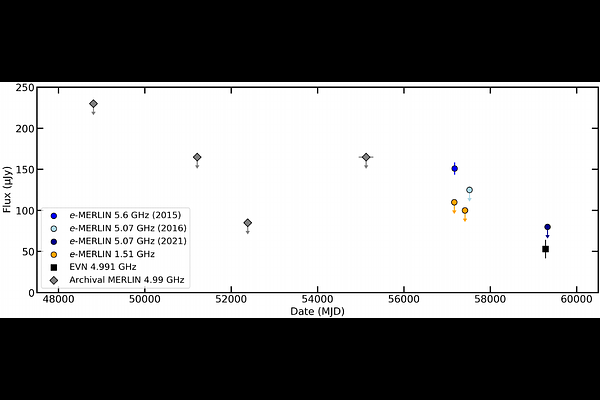An e-MERLIN & EVN radio counterpart to the ultraluminous X-ray source M82 X-1

An e-MERLIN & EVN radio counterpart to the ultraluminous X-ray source M82 X-1
D. Williams-Baldwin Jodrell Bank Centre for Astrophysics, School of Physics and Astronomy, The University of Manchester, Manchester, M13 9PL, UK, T. W. B. Muxlow Jodrell Bank Centre for Astrophysics, School of Physics and Astronomy, The University of Manchester, Manchester, M13 9PL, UK, G. Lucatelli Jodrell Bank Centre for Astrophysics, School of Physics and Astronomy, The University of Manchester, Manchester, M13 9PL, UK, R. J. Beswick Jodrell Bank Centre for Astrophysics, School of Physics and Astronomy, The University of Manchester, Manchester, M13 9PL, UK
AbstractUltra-luminous X-ray sources (ULXs) are X-ray bright (L$_{\rm X-ray} >$3$\times$10$^{39}$erg s$^{-1}$) extra-galactic objects that are powered by either neutron stars, or stellar or intermediate-mass black holes (IMBHs) but few have been detected in the radio waveband. In the nearby galaxy M82, the brightest ULX - M82 X$-$1, is thought to be associated with an IMBH but to date does not have a radio counterpart. We present deep wide-band reprocessed e-MERLIN images observed in 2015 May with an r.m.s. sensitivity of 7$\mu$Jy beam$^{-1}$ and report the discovery of a new radio source with an integrated flux of S$_{\rm \nu=4.88\,GHz}$ = 174$\pm$15$\mu$Jy, which is spatially co-incident with the Chandra X-ray position of M82 X$-$1. This source is not detected in archival MERLIN/e-MERLIN observations in the last three decades. A search for intra-observation variability in the 2015 e-MERLIN data was inconclusive, but a comparison with 1.5 GHz e-MERLIN observations taken a week prior yielded no detection. We also detect the source at the same position with milliarcsecond angular resolution in EVN+e-MERLIN data from 2021 March at 53$\pm$10$\mu$Jy. The radio source position is ICRF J2000 RA: 09$^{h}$55$^{m}$50.1172$^{s}$, Dec: +69$^{\circ}$40'46.606" ($\pm$1.5 mas). These radio fluxes are consistent with other radio-detected ULXs on the radio:X-ray plane and points towards a stellar/intermediate-mass black hole. The black hole mass inferred by the `fundamental plane of black hole activity' is 2650 M$_{\odot}$, but this value remains highly uncertain.